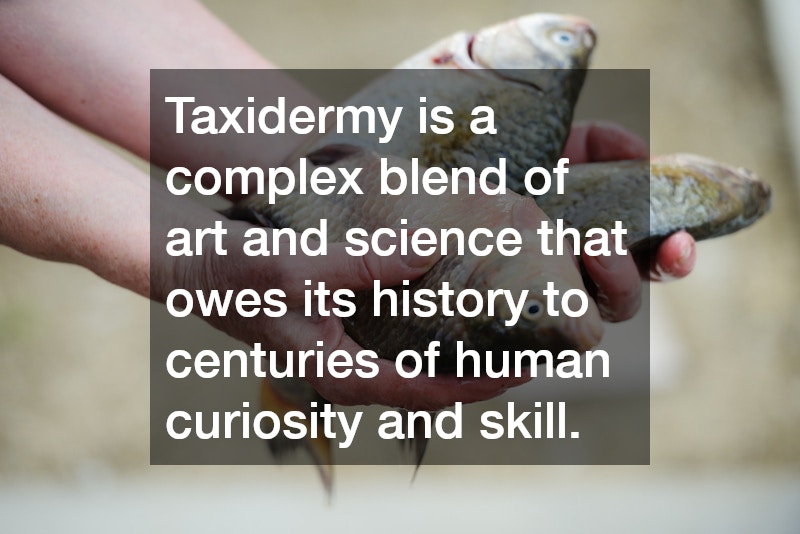Taxidermy is the art and science of preserving animals for display and scientific purposes. This ancient practice bridges both artistry and biology, drawing interest from those intrigued by nature and the macabre alike. For anyone hoping to explore this fascinating field, a fishing guide could offer insights into the specific techniques required for preserving aquatic specimens.
Historically, humans have sought to preserve animal forms for reasons ranging from spiritual to educational. From ancient Egypt to modern times, taxidermy has been shaped by changes in society’s relationship with nature.
This article will delve into its rich history and evolving practices.
What Is Taxidermy and How Does It Work?
Definition and History of Taxidermy
Taxidermy, derived from Greek words meaning “arrangement of skin,” is the practice of preparing, stuffing, and mounting animal skins. Its roots trace back to ancient Egypt, where animals were preserved for religious purposes. Over centuries, it evolved into a practice used for scientific and decorative purposes, becoming sophisticated in the Victorian era.
During the 19th century, taxidermy gained popularity as museums sought to educate the public about global wildlife. Innovations in chemicals and techniques allowed taxidermists to refine their craft with more lifelike results. This era also saw the rise of taxidermy competitions and exhibitions, cementing its cultural status.
Today, taxidermy encompasses a broad spectrum of purposes and styles, from traditional hunting trophies to contemporary art pieces. Digital technology and improved preservation practices continue to push the boundaries of what is possible.
Different Types of Taxidermy
Taxidermy can be broadly categorized into three types: traditional, dermoplasty, and rogue or artistic. Traditional taxidermy focuses on preserving the natural appearance for educational or trophy purposes. Dermoplasty involves creating detailed skins or casts for scientific study and model reproduction.
Modern interpretations, often called “rogue” taxidermy, allow artists to create imaginative sculptures that might combine elements from various animals. This form challenges traditional perceptions, blending fantasy and reality. Such works have gained popularity in art installations and galleries worldwide.
The Science Behind Taxidermy
A successful taxidermist combines knowledge of biology, chemistry, and anatomy to create lifelike specimens. Understanding the muscular and skeletal structure of animals is crucial in recreating accurate poses. Scientific skills are paired with artistic vision to achieve naturalistic representations.
Chemical knowledge is essential for preserving skins and preventing decomposition. This involves using various preservatives, such as borax or formaldehyde, and understanding their effects on tissue. Recent advancements focus on minimizing the environmental impact of these chemicals.
How to Start Taxidermy: A Step-by-Step Process
Preparing the Specimen
The initial step in taxidermy is acquiring a suitable specimen, often harvested ethically and quickly frozen to prevent decay. The skinning process must be performed with precision to ensure no damage to the fur or feathers. Detailed planning regarding positioning and expression should be determined before proceeding further.
This stage demands an understanding of the animal’s biology, specifically muscle groups and bone structures. Correctly identifying these will enable accurate shaping of the final mount. Meticulous documentation of the specimen’s original form aids in achieving authenticity later on.
Mounting Techniques
Several mounting techniques are utilized in taxidermy, each suited to different types and sizes of specimens. Traditional methods often involve building a manikin or supportive frame onto which the hide is fitted. The accuracy of pose and expression depends on the skillful construction of this framework.
Innovative techniques might include freeze-drying, used particularly for smaller animals and birds. This method offers exceptionally detailed results and reduces the time required for preparation. However, it demands specific equipment and skills, making it less accessible to beginners.
Finishing Touches and Preservation
The final steps in taxidermy involve grooming, painting, and applying gloss to simulate natural sheen. Realism is achieved through careful attention to detail in the eyes, ears, and nose, using dyes and airbrushing techniques. Such precision ensures the mount’s life-like appearance captivates viewers.
Grooming includes arranging fur or feathers and correcting any imperfections that have occurred during the mounting process. Special adhesives may be applied to secure the hide and prevent shifting. This stage demands a blend of artistic skill and patience.
Taxidermy is a complex blend of art and science that owes its history to centuries of human curiosity and skill. As explored, this practice offers a lens into our natural world and the intricate relationships between humans and nature. For those intrigued by the craft, numerous resources exist for further exploration and learning.
With its ongoing evolution in techniques and ethics, taxidermy continues to inspire and inform. It challenges practitioners to push the boundaries of realism while considering new conservation methodologies. As societal values change, so too does the framework within which taxidermists operate.

